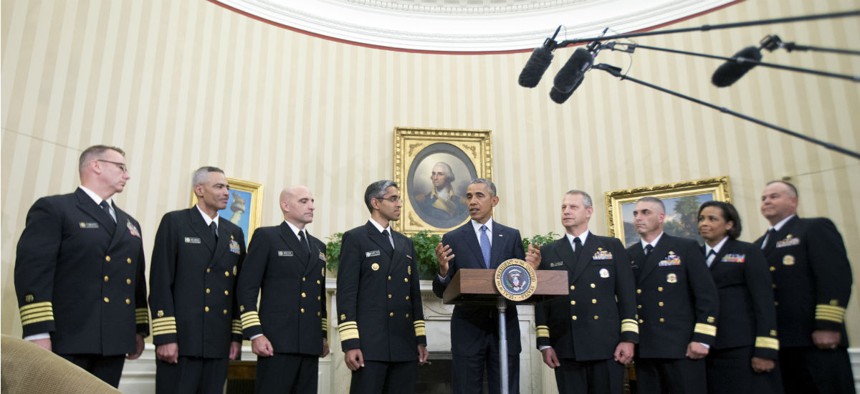
President Obama with members of the Public Health Service who participated in the Ebola response after awarding the Presidential Unit Citation in September 2015. Manuel Balce Ceneta/Associated Press
How the Government Bungled the Ebola Response
Agencies ultimately got it right -- after they first put federal personnel and the public at risk.
“That’s how we stopped the spread of Ebola in West Africa. Our military, our doctors, our development workers -- they were heroic; they set up the platform that then allowed other countries to join in behind us and stamp out that epidemic. Hundreds of thousands, maybe a couple million lives were saved.”
So President Obama proclaimed during his State of the Union address Tuesday, noting America’s ability to provide leadership in global crises. A new report from the Homeland Security Department inspector general, however, shows the U.S. government placed both federal screening personnel and the public at risk.
After initial fears of unpreparedness -- spurred after a Texas health-care worker contracted the disease while treating a patient -- the Obama administration's global response to the Ebola outbreak ultimately won plaudits across the political spectrum. The effort was led by Ron Klain, who Obama tapped as his Ebola czar.
Thousands of federal employees from a dozen departments and sub-agencies responded to the Ebola outbreak, which began in late 2014 and stretched into mid 2015. But the IG report showed that DHS and the Health and Human Services Department failed to spell out precisely which components would handle which responsibilities.
Instead, the two departments relied on a 2005 memorandum of understanding concerning response to an influenza outbreak. As a result, Customs and Border Protection took the lead on initial screenings of individuals returning from Ebola-infected countries. CBP officers took the temperatures of those passengers, conducted interviews, and contacted the Centers for Disease Control and Prevention if the passengers exhibited signs of the disease.
But CBP often improperly exempted federal employees and diplomats from the screenings, even when passengers identified themselves as coming from Ebola regions. The agency hired contractors to conduct travelers' temperature readings, though not every port of entry had such contractors in place. The agency said that where contractors were not present, CDC would conduct the readings, but CDC said it did not have the resources to do so.
In total, the government let 169 individuals returning from Ebola-affected countries into the United States without taking their temperature or being “otherwise cleared by health professionals.” DHS management took issue with this criticism, saying it documented the health of the 169 individuals in question. The IG said it could not verify the passengers “were not a risk to public health.”
While the unscreened passengers were small in number compared to the 20,000 travelers the government did screen, the IG said they still created vulnerability.
Adding to the problem was a lack of precautions for the screeners themselves. CBP did not always train its employees on the proper use of personal protective equipment, which all DHS employees potentially coming into contact with Ebola were required to wear. In some locations, CBP provided training two months after Ebola screening had already begun. DHS management also failed to inform screeners that they needed to maintain a 3-foot distance between themselves and the returning travelers.
Additionally, the Coast Guard failed to consistently follow policies that required CBP to screen and clear vessels before Coast Guard personnel boarded them. In some cases, the Coast Guard relied on self-reporting of Ebola-like symptoms instead of actually screening the passengers.
The IG also cited DHS for faulty and unreliable data in relation to Ebola screening.
Taken together, the IG said, “These deficiencies allowed passengers to enter the country without being fully screened and put DHS screening employees at higher risk of exposure to Ebola.”
In total, the IG recommended DHS make 10 changes in its policies for handling Ebola or other outbreaks. Those include better coordination within the department and between agencies; ensuring all ports of entry are screened by CBP; and better training on the use of personal equipment. DHS management agreed with all of the suggestions, and has already taken action to correct seven of them.







